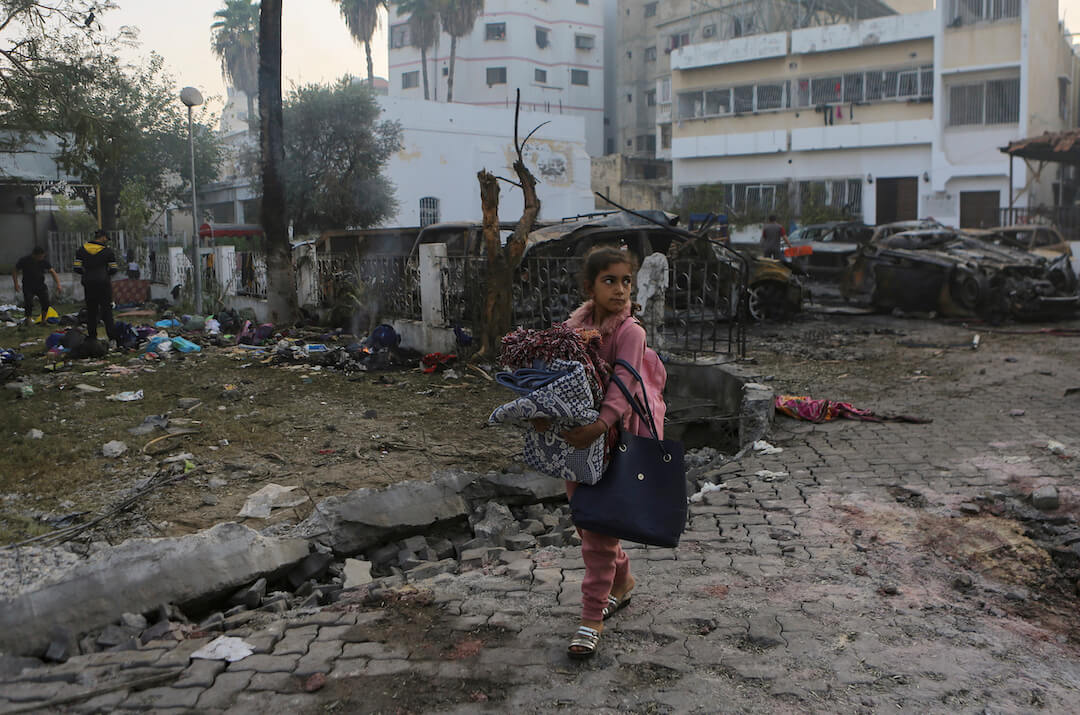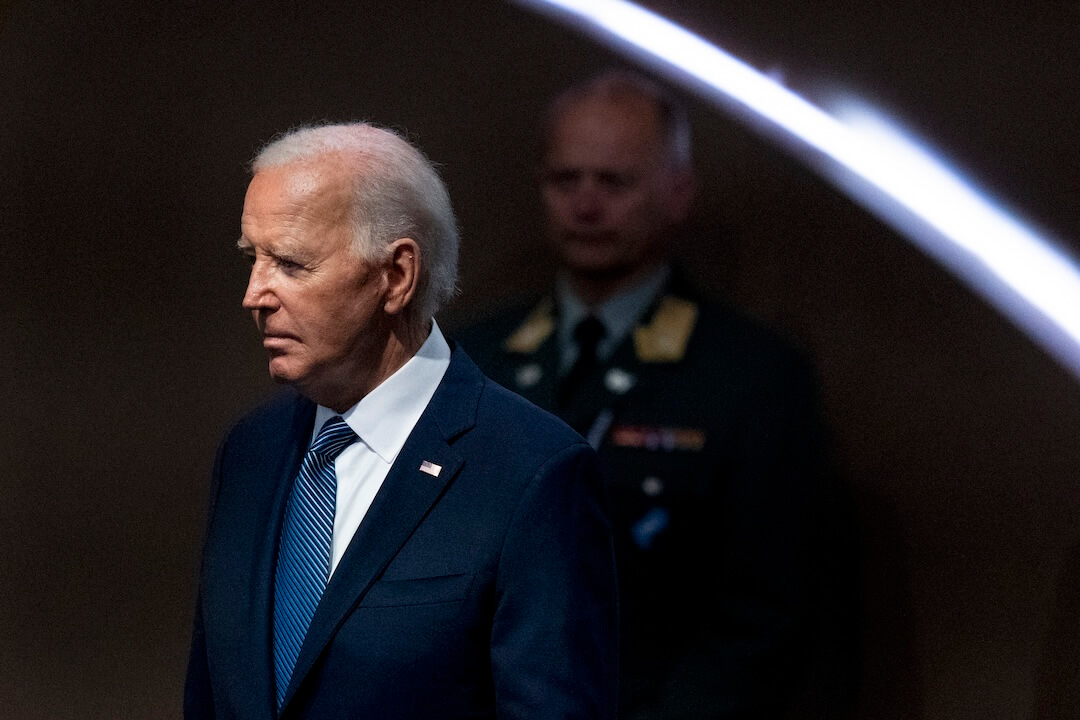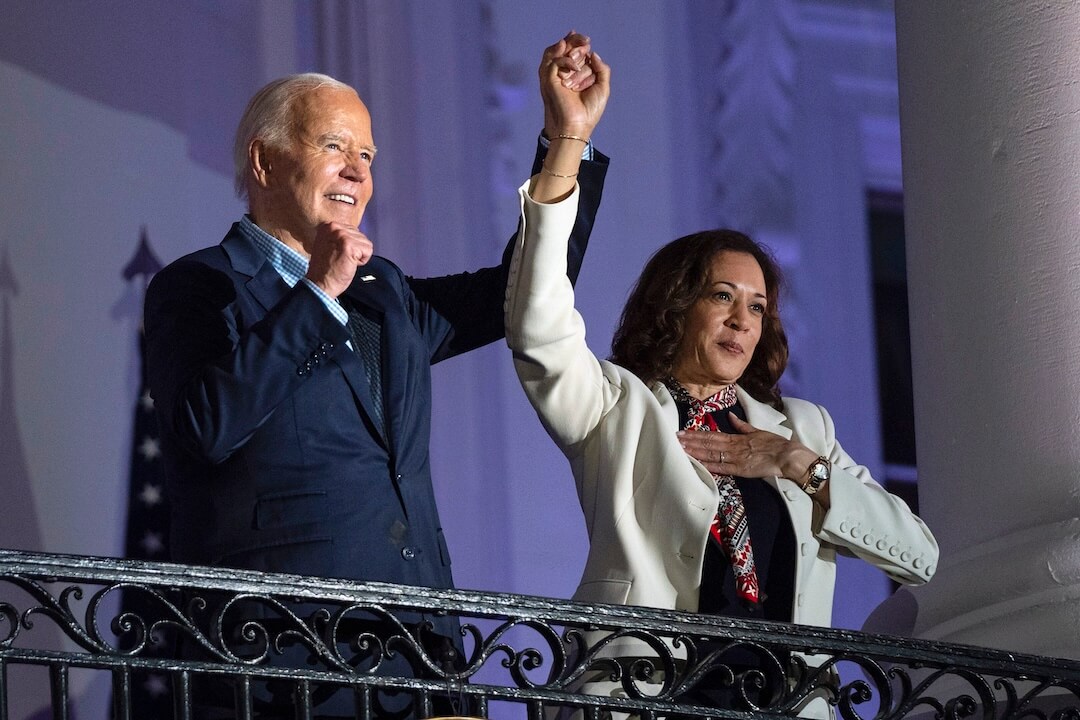Shortly after an explosion was reported at the al-Ahli Arab hospital in Gaza City on Oct. 17, The New York Times published a large headline at the top of its website:
“Israeli Airstrike Hits Gaza Hospital, Killing 500, Palestinian Health Ministry Says.”
Later, after Israeli intelligence disputed the claim, the Times headline changed:
“Israel and Palestinians Blame Each Other for Blast at Gaza Hospital That Killed Hundreds.”
In an extended editor’s note published Monday, the Times explained its decision to rewrite the headline, saying “the early versions of the coverage — and the prominence it received in a headline, news alert and social media channels — relied too heavily on claims by Hamas, and did not make clear that those claims could not immediately be verified. The report left readers with an incorrect impression about what was known and how credible the account was.”
Later reports, including a visual analysis from The Associated Press, lent credence to the Israeli Defense Forces’ claim that a rocket fired from Gaza broke apart in the air and landed on the hospital.
The Times note said that editors should have been more transparent about what they knew and what they didn’t know.
“Given the sensitive nature of the news during a widening conflict, and the prominent promotion it received, Times editors should have taken more care with the initial presentation, and been more explicit about what information could be verified,” the note said. “Newsroom leaders continue to examine procedures around the biggest breaking news events — including for the use of the largest headlines in the digital report — to determine what additional safeguards may be warranted.”
The Times wasn’t the only news organization to publish blaring reports that said the blast came from an Israeli airstrike. Reuters, The Associated Press, The Washington Post, CNN, the BBC, MSNBC and more all initially reported versions of the claim that an Israeli strike had killed hundreds at the hospital and have since corrected those reports.
The outcome, however, wasn’t limited to a series of mea culpas from news organizations. The Atlantic’s Yascha Mounk reported that the misreported news “quickly had huge real-world consequences.”
“The king of Jordan canceled a planned meeting with President Joe Biden. Mass protests broke out in cities across the Middle East, some culminating in attacks on foreign embassies. In Germany, two unknown assailants threw Molotov cocktails at a synagogue in Berlin,” Mounk wrote. “A wider regional war seemed to inch closer.”
As Poynter’s Tom Jones has written, these incidents are a “serious reminder of the importance of language and prudence when writing headlines on high-stakes stories where the information is still vague.” These high-profile mistakes can further erode trust in the press, which is already at near-historic lows.
As Mounk wrote, “Journalists and media executives understandably tend to apportion blame for their failings elsewhere. If people no longer trust quality outlets, the fault must lie with the ‘misinformation’ they encounter on social media. But such an easy allocation of responsibility won’t work when, marching in unison, major news organizations seem to have fouled up in as blatant a way as they have over this past week.”
By Ren LaForme, managing editor
Israel-Hamas war: At least 23 journalists have now been killed

Journalists observe as Palestinians inspect the rubble of a building after it was struck by an Israeli airstrike, in Gaza City, Sunday, Oct. 8, 2023. Journalists reporting in Gaza need to worry about basic survival for themselves and their families in addition to getting out the story of a besieged population. (AP Photo/Fatima Shbair, File)
On Oct. 13, Poynter reported that at least 11 journalists had been killed in the fighting between Israel and Hamas. Just 10 days later, that number has grown to 23, and many other journalists have been injured or are missing, Axios’ Sara Fischer reports.
Nineteen of the journalists who were killed in the region were Palestinian, most of whom were killed during Israeli bombardments.
“Journalists in Gaza face particularly high risks as they try to cover the conflict in the face of a ground assault by Israeli troops, devastating Israeli airstrikes, disrupted communications, and extensive power outages,” the Committee to Project Journalists said in a report on the deaths.
In addition, three Israeli journalists were killed in Hamas attacks, and one Lebanese journalist was killed after an Israeli missile attack, Lebanon’s government said.
“It’s a staggering number of deaths to be documented across such a short period of time,” Fischer writes.
In comparison, 15 journalists have been killed in the entire Ukraine-Russia war, which began in February 2022. In all, 67 journalists and media workers were killed in 2022, according to a CPJ report.
The Washington Post’s Jennifer Hassan and Niha Masih wrote about the stories of some of the journalists who have been killed in “Journalists killed in the Israel-Gaza war: A look at the lives lost.”
The CPJ also said it is investigating “numerous unconfirmed reports” of other journalists being killed, and other reports of journalists who are missing, detained, hurt or who have been threatened. The organization is also investigating damage to media offices and journalists’ homes.
CPJ Middle East and North Africa program coordinator Sherif Mansour made a plea for Israeli and Hamas forces to respect the role of journalists.
“CPJ emphasizes that journalists are civilians doing important work during times of crisis and must not be targeted by warring parties,” Mansour said. “Journalists across the region are making great sacrifices to cover this heartbreaking conflict. All parties must take steps to ensure their safety.”
By Ren LaForme, managing editor
PolitiFact breaks down the detrimental effects of Elon Musk’s Twitter changes
PolitiFact on Monday published a detailed breakdown of how Elon Musk — through changes to Twitter, now X — has led the platform down a path to even greater disinformation.
According to the story by staff writer Madison Czopek, just hours after federal filings showed Musk offered tens of billions to purchase Twitter, the business magnate shared his vision for the social media platform in a Vancouver TED Talk. He said that “having a public platform that is maximally trusted and broadly inclusive is extremely important to the future of civilization.”
But, as Czopek meticulously reports, since purchasing Twitter for $44 billion, Musk has “removed guardrails” meant to restrict the flow of mis- and disinformation. Ways in which he’s done this include the implementation of the paid “blue check” accounts and sharing ad revenue with its largest content creators.
“A year into Musk’s ownership, however, experts say the platform formerly known as Twitter has, through its practices, eroded trust and fanned misinformation,” Czopek wrote. “It disabled features that helped users avoid being duped by false information and established new systems that promote confusion and encourage the spread of false claims.”
Czopek interviewed experts and cited research that shows the rise in not only misinformation but also hate speech on X. She also reported how the platform itself has thwarted researchers’ efforts to analyze critical trends.
Of note was the section on the transformation of the blue check mark. As Czopek notes, the mark was a “once-coveted indicator that an account holder’s identity was authentic.” A user who had one was considered verified. But on X, “paid users reign supreme.”
The much-talked about “Twitter Blue” (now “X Premium”) enables anyone to buy a blue check mark. Their posts, unlike those who decline to pay, are prioritized by X’s algorithm. What followed were rampant impersonations on the platform, and later Musk’s announcement that only subscribers’ tweets would be recommended on the “For You” page — which is the feed users see when they open the platform.
Czopek reported that experts believe these changes were “among the most influential to the proliferation of misinformation on X.”
If you’re interested in understanding just how much X has characteristically changed since Musk purchased it, Czopek’s story is well-sourced (with more than 100 sources listed at the bottom of the article) and well worth your time.
By Amaris Castillo, contributor
Media tidbits and links
- The New York Times’ Adam Liptak reports on two applications, one from NBCUniversal and one a coalition of news organizations (including the Times), to broadcast or record one of former President Donald Trump’s trials. Liptak writes, “In a pair of filings this month, news organizations asked a federal judge in Washington to allow live television coverage of the trial of President Donald J. Trump on charges that he conspired to undermine the 2020 election. They face a distinctly uphill fight.”
- The Detroit News fired Pulitzer Prize-winning columnist Charlie LeDuff after he used a vulgar phrase in a tweet about Michigan Attorney General Dana Nessel. The Detroit Metro Times’ Steve Neavling has more (including, be warned, the phrase LeDuff used).
- Advertisers have found a new way to reach streaming audiences: through pause menus. Variety’s Brian Steinberg reports that “So-called ‘pause ads’ — they only turn up a few seconds after a viewer has decided to halt the programming, and not every time one does — are seeing new movement in the streaming world, with the format appearing more frequently on Hulu since July, according to Josh Mattison, senior vice president of revenue management and operations for Disney Advertising. Pause ads are also in motion in venues such as NBCUniversal’s Peacock and Warner Bros. Discovery’s Max.”
- TheWrap’s Natalie Korach with “Israel Shows Raw Footage of Hamas Atrocities to Journalists.”
- Axios’ Sara Fischer and Cuneyt Dil with the scoop: “D.C. lawmakers to introduce new bill funding local news via vouchers.”
- Rolling Stone editor-in-chief Noah Shachtman writes, “In the wake of our founder’s offensive comments, we’re taking a hard look at where we’ve been and where we’re going.”
More resources for journalists
- Hiring? Post jobs on The Media Job Board — Powered by Poynter, Editor & Publisher and America’s Newspapers.
- Poynter ACES Introductory Certificate in Editing (Online) — Enroll now.
- How to Improve Your Coverage of LGBTQ+ Communities (Webinar) — Start anytime.
- How Any Journalist Can Earn Trust (Self-directed course) — Enroll now.
Have feedback or a tip? Email Poynter senior media writer Tom Jones at tjones@poynter.org.
The Poynter Report is our daily media newsletter. To have it delivered to your inbox Monday-Friday, sign up here.







